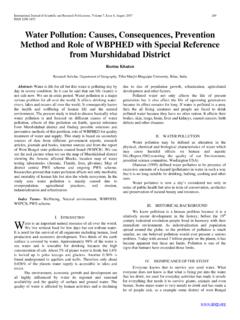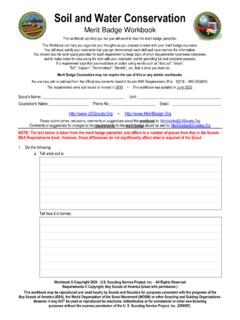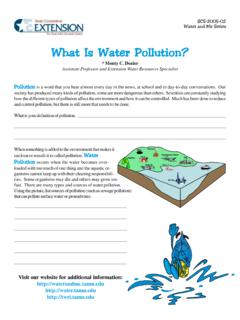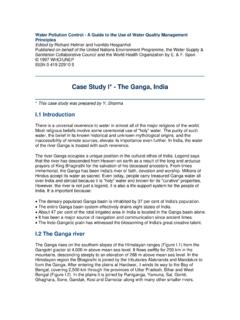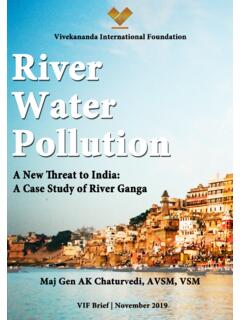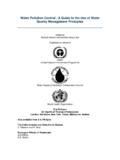Transcription of Water Pollution and its Impact on the Human Health
1 JOURNAL OF ENVIRONMENT AND HUMANISSN(Print): 2373-8324 ISSN(Online): 2373-8332 DOI: 2, Number 1, January 2015 JOURNAL OF ENVIRONMENT AND HUMANW ater Pollution and its Impact on the HumanHealthJoshua Nizel Halder1*, M. Nazrul Islam21 Department of Environmental Engineering, Sangji University, Wonju, Kangwon-do 220-702, Republic of Korea2 Department of Environmental Science, Daffodil International University, Dhaka 1207, Bangladesh*Corresponding author: Pollution has been one of the main topics in the environmental issue of urban Dhaka, the capital cityof Bangladesh. This study was conducted to find out the Pollution situation of Turag river and the healthproblem of the surrounding residents. The results clearly determine that the Water quality of Turag rivermay not be in a position to sustain the aquatic life and not suitable for using domestic purpose. This isindicated by the very low dissoloved oxygen (DO) levels and other measured parameters in the river.
2 Themaximum recorded values of pH, color, turbidity, biochemical oxygen demand (BOD5), hardness, totaldissolved solids (TDS), chloride (Cl-), carbon-di-oxide (CO2) and chemical oxygen demand (COD) mg/L, 625 ptcu, , mg/L, 1816 mg/L, 676mg/L, 5 mg/L, , and 78 mg/L, respectively. Themaximum concentration of turbidity, BOD, hardness, TDS, and COD found in the Turag river is much higherthan the standard permissible limit. The study also provides evidence that local communities are sufferingfrom a variety of Health problems including skin, diarrhea, dysentery, respiratory illnesses, anemia andcomplications in childbirth. Yellow fever, cholera, dengue, malaria and other epidemic diseases are alsoavailable in this area. Furthermore, the people are suffering by the odor Pollution and respiratory :Turag River; Pollution ; Impact ; Human Health1. INTRODUCTIONW ater is the most vital element among the natural resources, and is critical for the survival of all living organismsincluding Human , food production, and economic development.
3 Today there are many cities worldwide facing anacute shortage of Water and nearly 40 percent of the world s food supply is grown under irrigation and a wide varietyof industrial processes depends on Water . The environment, economic growth, and developments are all highlyinfluenced by Water -its regional and seasonal availability, and the quality of surface and groundwater. The quality ofwater is affected by Human activities and is declining due to the rise of urbanization, population growth, industrialproduction, climate change and other factors. The resulting Water Pollution is a serious threat to the well-being ofboth the Earth and its is a deltaic land created and flown over by numerous rivers; the land is also consistently nourishedby their Water flows. Pollution of river bodies has become a major problem that is becoming critical because ofinadequacy or non-existence of surface Water quality protection measures and sanitation.
4 Lagoons, rivers and streams36 Water Pollution and its Impact on the Human Healthare sinks for wastes. Wastes are most often discharged into the receiving Water bodies with little or no regard totheir assimilative capacities. The discharge of raw sewage, garbage, as well as oil spills are threats to the dilutingcapabilities of the lagoons and rivers in the major cities. The natural purification of polluted waters in itself is neverfast, while heavily polluted Water may traverse long distance in days before a significant degree of purification isachieved [1,2]. In addition, rivers and canals are becoming increasingly polluted from industrial wastewater dumpedby factories, many of them in the textile industry. Leather tanneries are also a significant source of toxic pollutants tothe air and Water . The Water Pollution threatens food production and is raising both environmnetal and Human healthconcerns [3 8].Dhaka city is surrounded by a number of rivers and canals of which Turag, Buriganga, Dhaleshwari, Balu andShitalakhya are the important ones.
5 Because of the lack of the Water resources management plan and policies, boththe quality and quantity of Water in these rivers have reached a very critical situation that does not allow its instantuse. The rivers Buriganga, Shitalakhya, Turag, and Balu have been so extremely polluted that these have turned intothe rivers of poison. The poisonous waters of these rivers have not only been killing all its aquatic life but also beenposing Health hazards to the dwellers of the city. These rivers receive partially treated and untreated sewage effluent,sewage polluted surface run-off and untreated industrial effluent from nearby residential and industrial areas. Sourcesof Pollution of the Water in these rivers also include various industrial discharge, domestic waste; indiscriminatethrowing of pathological and commercial wastes, etc. Because of this, Water quality of these rivers is deterioratingday by day [9 13].River Pollution has been one of the main topics in the environmental issue of urban Dhaka.
6 The rivers surroundingthe capital city, including the Turag have been steadily experiencing complicated problems like Pollution andencroachment that have almost suffocated these valuable lifelines of the city [14 16]. The Pollution of the Turag riverfound in two points with extreme Pollution especially from the Buriganga third bridge to the Tongi bridge. Thesetwo Pollution points of the river homing in on the sources and causes of Pollution , its impacts on the surroundingenvironment and possible sustainable remedies. However, the specific objectives of the study were as show the variations in different Water quality parameters along a strip of the river due to the disposal ofuntreated industrial waste and season change (dry and wet); and2. To analyze the Health problems created by the MATERIALS AND Locale of the StudyThis study was conducted in a 2 km long strip of Turag river (Figure 1(a)andFigure 1(b)) which started fromTongi bridge following the river parallel to the Ashulia road.
7 The average width of the river along this section is15-20 meters; average depth during wet season is 4-6 meters and during dry season 2-4 Sources of DataThe sources of data are divided in to two categories. The data which were collected from the field or study area arecalled the primary data. Primary data were collected by the interviewing the people of study area and/or by makingsurvey on a topic of the study. The secondary data are the data which were collected from any books, journals,previous research paper or any other document which contain the topics related to the OF ENVIRONMENT AND Human (a)(b)Figure Area along the Turag River (a); A Closer View of the Study Area (b)In this study the primary data were the pictures, sampling data, interviews of people, field observation etc. Thefield observation obtain the physical condition of the study. In case of secondary data, map and information has beencollected from Department of Environment (DOE), Bangladesh Water Development Board (BWDB), BangladeshUniversity of Engineering and Technology (BUET) and Institute of Water Modelling (IWM).
8 Also from the annualreport of World Bank annual report of Water quality and environment of Dhaka Bangladesh , special report fromthe Department of Fisheries (DoF), the Management of Aquatic ecosystem through Community Husbandry (MACH),and the Turag project of the Bangladesh Center for Advance Data Collection MethodsThe steps that have been adopted to attain the objectives of the study were as data were obtained from field observation and this was needed to know about the existing physical andenvironmental condition of the data have been collected from DOE, BWDB, BUET and IWM, special report from the DoF, MACH,the Turag project of the Bangladesh Center for Advance Samples and photographs have been collected from different locations of the Turag river and watersamples tested in the MIST Environmental Engineering surface Water quality data has been collected from DOE and Environmental laboratory in CivilEngineering department of BUET as test quality and Pollution loads analyzed to find out the present Water quality scenario, trend of waterpollution and percent of increase in Pollution loading.
9 Besides, reports, thesis, journals and expert opinionswere collected from different organizations and group discussions (FGDs) and in-depth interviews with community members to identify their perceivedcurrent and historical Health problems. The second involved the gathering of secondary data and the undertakingof interviews with Health workers in the area to determine whether the perceived changes to Health expressed bythe local population matched the Health trends observed by local Health professionals. To collect this data, ourtool was taking Interview with the people of this location. The respondent persons were fisherman, boatman,teacher, local people, farmer, Health workers, Health professionals and Pollution and its Impact on the Human HealthWater quality data have analyzed by Microsoft Excel standard participatory rural appraisal (PRA) methods followed to analyze data, collected from the local peopleconcerning their perception.
10 Some questionnaires designed and used to interview the people. All the data wereanalyzed by Microsoft Excel Sample CollectionSurface Water samples of the rivers were collected from four different points of the river in two seasons during theperiod of April 2013 to July 2013 covering dry and wet periods. Various Water quality parameters were monitoredand a detailed field survey has been conducted within the study area. Proper sampling procedure was followed whilecollecting the Sample Handling and PreservationAppropriate sample handling and preservation is essential to ensure data quality. Factors considered are listed as:(a) clean plastic containers are typically used for inorganic samples, with glass containers used for organic analyses;(b) proper sample preservation is important if accurate and representative results are to be obtained from the samplingefforts. In general, all samples are placed on ice in the dark and (c) analyses should be initiated as soon as possibleafter collection to avoid sample Sample DepthsSelection of sampling depth varies with the purpose of work and the parameter to be tested.
